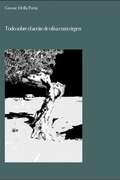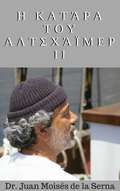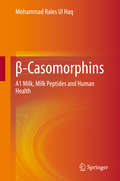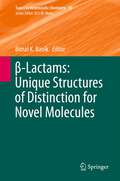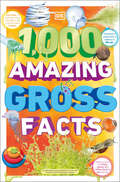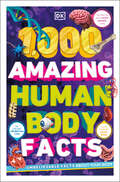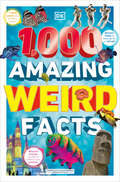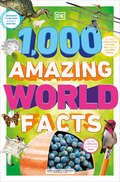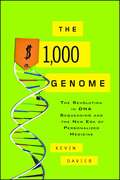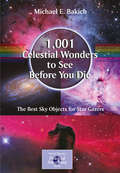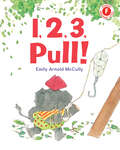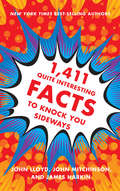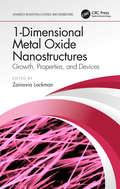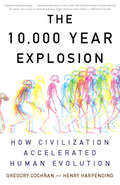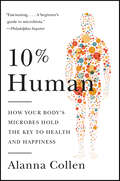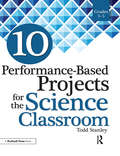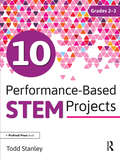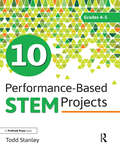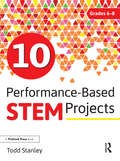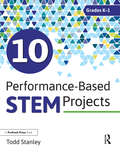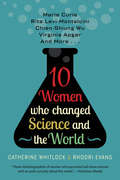- Table View
- List View
オリーブオイルのすべて
by Giosue Della Porta Miyuki Yamamotoエキストラバージンオリーブオイルのすべてが凝縮された一冊 オリーブの歴史から,栽培方法,オイルの生産工程,上質オリーブオイルを選ぶ基準,そして豊富な栄養成分の解説まですべてがわかる 生産基準をクリアしたイタリア産DOP認証オイルを州別に,表と一緒に詳しく説明 シンプルでありながらも,オリーブオイル初心者から,愛好者,専門家にまで役立つ情報がいっぱいです
Η Κατάρα του Αλτσχάϊμερ ΙΙ
by Juan Moises de la Serna Konstantinos MouratisΤι συμπώματα προκαλεί; Πώς γίνεται η διάγνωση; Πόσα άτομα έχουν νοσήσει; Μάθε για τις τελευταίες έρευνες σχετικά με την ασθένεια του Άλτσχάϊμερ. Κάθε μέρα πραγματοποιούνται νέες ανακαλύψεις για τη νόσο του Αλτσχάϊμερ αλλά αυτές δεν γίνονται γνωστές παρά μόνο στους ειδικούς και στους ενδιαφερόμενους γιατρούς. Αυτό το βιβλίο στοχεύει στο να ξεπεραστεί αυτό το πρόβλημα και να γίνει γνωστή η πρόοδος που έχει επιτευχθεί σχετικά με το Αλτσχάϊμερ.
القانون في الطب 2
by ابن سينااعلم أن المرارة كيس معلّق من الكبد إلى ناحية المعدة من طبقة واحدة عصبانية ولها ضمّ إلى الكبد ومجرى فيه يجذب الخلط الرقيق الموافق لها والمرار الأصفر ويتصل هذا المجرى بنفس الكبد والعروق التي فيها يتكون الدم وله هناك شعب كثيرة غائصة وإن كان مدخل عمودها من التقعير والفم ومجرى إلى ناحية المعدة. والأمعاء ترسل فيه إلى ناحيتهما فضل الصفراء على ما ذكرناه في الكتاب الأول. وهذا المجرى يتصل أكثر شعبه بالاثني عشري وربما اتصل شيء صغير منه بأسفل المعدة وربما وقع الأمر بالضد فصار الأكبر المتصل بالوعاء الأغلظ إلى أسفل المعدة والأصغر إلى الاثني عشري. وفي أكثر الناس هو مجرى واحد متصل بالاثني عشري. وأما مدخل الأنبوبة المصاصة للمرارة في المرارة فقريب من مدخل أنبوبة المثانة في المثانة. ومن عادة الأطباء الأقدمين أن يسموا المرار الكيس الأصغر كما أنه من عادتهم أن يسموا المثانة الكيس الأكبر ومن المنافع في خلقة المرارة تنقية الكبد من الفضل الرغوي وأيضاً تسخينها كالوقود تحت القدر وأيضاً تلطيف الدم وتحليل الفضول وأيضاً تحريك البراز وتنظيف الأمعاء وشدّ ما يسترخي من العضل حوله وإنما لم يخلق في الأكثر للمرارة سبيل إلى المعدة لتغسل رطوباتها بالمرة كما تغسل بها في رطوبات الأمعاء لأن المعدة تتأذى بذلك وتغثّي ويفسد الهضم فيها بما يخالط الغذاء من خلط رديء ويأتيها من العرق الضارب. وللعصبة التي تتصل بالكبد شعبتان صغيرتان جداً والمرارة كالمثانة طبقة واحدة مؤلفة من أصناف الليف الثلاثة وإذا لم تجذب المرارة المرار أو جذبت فلم تستنق عنه حدثت آفات فإن الصفراء إذا احتبست فوق المرارة أو رمت الكبد وأورثت اليرقان وربما عفنت وأحدثت حميات رديئة. وإذا سالت إلى أعضاء البول بإفراط قرحت وإذا سالت إلى عضو ما أحدثت الحمرة والنملة وإذا دبت في البدن كله ساكنة غير هائجة أحدثت اليرقان وإذا سالت عن المرارة إلى الأمعاء بإفراط أورثت الإسهال المراري والسحج.
β-Casomorphins: A1 Milk, Milk Peptides and Human Health
by Mohammad Raies Ul HaqThis book compiles the latest research on the A1 and A2 forms of cow milk, and attempts to show a correlation between the type of cow milk consumption and reported incidence of certain diseases (type 1 diabetes mellitus, cardiovascular diseases, sudden infant death syndrome and neurological disorders). Cow milk generally contains two types of β-casein, A1 or A2. The book describes the A1/A2 hypothesis, its foundation and the genetics behind it. It discusses the two forms of milk and why one is considered more harmful than the other. Seeking to provide a balanced view of the milk types, the book’s initial chapters highlight the structure, function and physiological activity of β-casomorphins. Subsequent sections describe the health concerns associated with A1 milk, and the various case studies and research surrounding it. In turn, the arguments against the hypothesis put forward by EFSA, American Nutritionists and Truswell are also highlighted. The book does not make any recommendations for dairy consumers; rather, it is a collection of essential data both in favour and against the hypothesis. Further mechanistic studies involving well-designed animal and human trials at the cellular, molecular, biochemical and immunological levels will be needed in order to draw sound conclusions. Overall, the hypothesis is fascinating, and possibly significant. However, verified and authenticated research with reproducible results is needed to make final consumer recommendations. This timely book offers a valuable resource for researchers and students of dairy science, as well as industry experts.
β-Lactams: Unique Structures of Distinction for Novel Molecules
by Bimal K. BanikI. Ojima * E. S. Zuniga * J. D. Seitz: Advances in the Use of Enantiopure β-Lactams for the Synthesis of Biologically Active Compounds of Medicinal Interests.- I. Fernández * Miguel A. Sierra: β -Lactams from Fischer Carbene Complexes: Scope, Limitations, and Reaction Mechanism.- Bablee Mandal * Basudeb Basu: Synthesis of β-Lactams Through Alkyne-Nitrone Cycloadditions.- T. T. Tidwell: Preparation of Bis-β-Lactams by Ketene-Imine Cycloadditions.- Edward Turos: The Chemistry and Biology of N-Thiolated β-Lactams.- Indrani Banik * Bimal K. Banik: Synthesis of β-Lactams and Their Chemical Manipulations Via Microwave-Induced Reactions.
0606 Vigyan - Himachal Pradesh Board
by Himachal Pradesh School Siksha BoardThis book is the basic text book of subject science prescribed by the himachal pradesh board for the students of class 6th. The accessible version of the book doesn’t leave any part of the book. Students and aspiring civil servants must read this to get success in the state and national level examinations.
0706 Vigyan class 7 - Himachal Pradesh Board: 0706 विज्ञान वर्ग 7 - हिमाचल प्रदेश बोर्ड
by Himachal Pradesh School Shiksha BoardThis book is the basic text book of subject Science prescribed by the himachal pradesh board for the students of class seven. The accessible version of the book doesn’t leave any part of the book. Students and aspiring civil servants must read this to get success in the state and national level examinations.
0806 Vigyan class 8 - Himachal Pradesh Board: 0806 विज्ञान वर्ग 8 - हिमाचल प्रदेश बोर्ड
by Himachal Pradesh School Shiksha BoardThis book is the basic text book of subject Science prescribed by the himachal pradesh board for the students of class 8th. The accessible version of the book doesn’t leave any part of the book. Students and aspiring civil servants must read this to get success in the state and national level examinations.
1,000 Amazing Gross Facts (DK 1,000 Amazing Facts)
by DKDive into a world of gross facts and discover the secret science of everything icky and sticky. This irresistibly disgusting book for children will teach you all you need to know about all kinds of animal and human waste and goo – what it&’s for, how it&’s made, where it goes, and lots more. Did you know that the global population produces more than a million tons of poo every day? Or that the ancient Egyptians used animal excrement in their medicine? That sea cucumbers can vomit their sticky insides when threatened, yet still survive? Children aged 9+ will love all these facts and more, presented either with jaw-dropping CGI illustrations or eye-popping photography – plus additional boxes feature diagrams that make information easy to understand. Celebrate your child's curiosity as they explore:- 1,000 jaw-dropping, mind-blowing facts that will be sure to wow family and friends. - Stunning CGI graphics, fun visual comparisons, and diagrams make stats and facts easy to understand.- Science boxes that are illustrated with engaging diagrams to explain information.- Simple and easy to understand images explaining the science behind the weird and wonderful facts.This book of gross, mind-blowing facts will make the ideal gift for kids who love all things weird and wonderful - especially slime and goo! With endlessly interesting information and incredible visuals, 1,000 Amazing Gross Facts is the perfect way to entertain and amuse your friends, family, and yourself. In fact, you&’ll never look at poo, goop, and gunk in the same way again!More in the SeriesIf you like 1,000 Amazing Gross Facts then why not complete the collection? Journey to the Jurassic era with 1,000 Amazing Dinosaur Facts and learn mind-boggling facts about the scariest animals ever to walk the Earth!
1,000 Amazing Human Body Facts (DK 1,000 Amazing Facts)
by DKStun family and friends with mind-boggling facts about the human body!Packed with amazing facts and visual representations, this extraordinary book answers questions about the human body. Find out just what makes our bodies so incredible with enough blood and guts, intestines, and eyeballs to satisfy the most curious kids.Filled with astounding facts and popping photography, this science book for kids 9 years and older makes the science of the human body exciting and fun. Inside you&’ll find: • 1,000 jaw-dropping, mind-blowing facts. • Stunning images that help explain facts about the body in a way that kids can understand. • Fast fact science boxes illustrated with engaging info graphics to cover essential info on how the body works. • Additional photo stories on each spread, revealing something a bit more quirky and fun. • Amazing pictures magnified many times show you parts of the body as you&’ve never seen them before. • Simple, easy-to-understand secondary artwork that makes the main images on each spread the stars of the show. • Fun, accessible text written to excite and entertain the target age group and adults too! Did you know your DNA could stretch to the sun and back not once but 16 times, or that you shed and regrow a whole new layer of skin every 39 days? It Can&’t Be True! Human Body! is full of bite-size, fascinating bits of information about the incredible abilities of human bodies. Children will be captivated by this book on human body facts, and its science &“question and answer&” format. Discover the surprising answers to questions like how big is your stomach, or how big are your lungs?Packed with vibrant computer-generated images, this science book for children explains an impressive number of human body facts with breathtaking visual comparisons that reveal just how amazing your body is. Topics covered include what the body is made of, circulation and respiratory systems, skeletal and muscle systems, and so much more!More incredible facts to discover DK&’s It Can&’t Be True! series covers fascinating topics in an easy-to-read, question and answer format to keep children interested and engaged. These books are wonderful gifts for kids who love science, and will satisfy their most pressing questions.
1,000 Amazing Weird Facts (DK 1,000 Amazing Facts)
by DKDive into a collection jaw-dropping facts and mind-blowing information about our weird and wonderful world. This weird and wonderful fact book for children will teach them about all kinds of bizarre beasts, incredible places and peculiar phenomena. Did you know there's a plant that eats mice? Or that you can dip your toe in a rainbow-colored river? Whether it's geography, people, places, animals, plants, or weather, 1,000 Amazing Weird Facts is the ideal book for curious young minds who are fascinated by our amazing planet. Children aged 9+ will love all these facts and more, presented either with jaw-dropping CGI illustrations or eye-popping photography – plus additional boxes feature diagrams that make information easy to understand. This mind-blowing fact book for children offers: 1,000 jaw-dropping facts that will be sure to wow family and friends. Striking CGI graphics, fun visual comparisons, and diagrams make stats and facts easy to understand.Simple and easy to understand images explaining the science behind the weird and wonderful facts.Whether it's geography, people, places, animals, plants, or weather, 1,000 Amazing Weird Facts is the ideal book for curious young minds who are fascinated by our amazing planet. From fiery tornadoes flying across the sky to huge sinkholes eating up the earth, each example is illustrated with jaw-dropping images and handy fast facts that provide the explanations behind the stories. More in the SeriesIf you like 1,000 Amazing Weird Facts then why not complete the collection? Journey to the Jurassic era with 1,000 Amazing Dinosaur Facts and learn mind-boggling facts about the scariest animals ever to walk the Earth, or discover the secret science of everything icky and sticky with 1,000 Amazing Gross Facts.
1,000 Amazing World Facts (DK 1,000 Amazing Facts)
by DKDive into a world of mind-blowing facts that may defy belief, but they are all absolutely true!Can you believe the Eiffel Tower would fit inside a Sahara sand dune? Wow your friends and amaze your family with hundreds of new facts in this fun-filled, picture-packed bumper book for children aged 9+. 1,000 Amazing World Facts contains striking images, visual comparisons, and informative diagrams in one unforgettable journey around the world. From the tiniest microchip to our unimaginably enormous Universe, no subject is left unexplored. Celebrate your child's curiosity as they explore:- 1,000 mind-blowing facts that will be sure to wow family and friends. - CGI graphics, fun visual comparisons, and diagrams make stats and facts easy to understand.- Science boxes that are illustrated with engaging diagrams to explain information.Did you know that Earth could fit inside Jupiter more than 1,000 times? Or the blue whale's heart is as big as a car? Children will love all these facts and more, presented either with impressive CGI illustrations or eye-popping photography – plus additional boxes feature diagrams that make information easy to understand. More in the SeriesIf you like 1,000 Amazing World Facts then why not complete the collection? Journey to the Jurassic era with 1,000 Amazing Dinosaur Facts, learn about all things weird and wonderful with 1,000 Amazing Weird Facts, or discover the secret science of everything icky and sticky with 1,000 Amazing Gross Facts.
The $1,000 Genome
by Kevin DaviesIn 2000, President Bill Clinton signaled the completion of the Human Genome Project at a cost in excess of $2 billion. A decade later, the price for any of us to order our own personal genome sequence--a comprehensive map of the 3 billion letters in our DNA--is rapidly and inevitably dropping to just $1,000. Dozens of men and women--scientists, entrepreneurs, celebrities, and patients--have already been sequenced, pioneers in a bold new era of personalized genomic medicine. The $1,000 genome has long been considered the tipping point that would open the floodgates to this revolution. Do you have gene variants associated with Alzheimer's or diabetes, heart disease or cancer? Which drugs should you consider taking for various diseases, and at what dosage? In the years to come, doctors will likely be able to tackle all of these questions--and many more--by using a computer in their offices to call up your unique genome sequence, which will become as much a part of your medical record as your blood pressure. Indeed, many experts are advocating that all newborns have a complete genome analysis done so that preventive measures and preemptive medicine can begin early in life. How has this astonishing achievement been accomplished? And what will it mean for our lives? To research the story of this unfolding revolution, critically acclaimed science writer Kevin Davies has spent the past few years traveling to the leading centers and interviewing the entrepreneurs and pioneers in the race to achieve the $1,000 genome. He vividly brings to life the extraordinary drama of this grand scientific achievement, revealing the masterful ingenuity that has transformed the process of decoding DNA and delivering the information it possesses to the public at large. Davies also profiles the future of genomic medicine and thoughtfully explores the many pressing issues raised by the tidal wave of personal genetic information. Will your privacy be protected? Will you be pressured, by insurance companies or by your employer, to get your genome sequenced? What psychological toll might there be to discovering you are at risk for certain diseases like Alzheimer's? And will the government or the medical establishment come between you and your genome?One thing that is not in question is that we are moving swiftly into the personalized medicine era, and The $1,000 Genome is an essential guide to this brave new future.
1,001 Celestial Wonders to See Before You Die: The Best Sky Objects for Star Gazers (The Patrick Moore Practical Astronomy Series)
by Michael E. Bakich1,001 Celestial Wonders is a guide to the night sky's brightest and most fascinating objects. Each target is accessible to amateur astronomers using medium-sized telescopes from a dark site. In fact, many are so bright they remain visible under moderate light pollution, as from the outskirts of a city or the suburbs of a town. The book provides a chronological target list, making it easy to use. No matter what night you choose, this book will show you many of the most memorable objects to observe, whether you are using a small telescope or even binoculars, or an instrument of larger aperture. This is far more than just a list of interesting objects. It is structured so that objects of various observing difficulty are included, which will help readers become better observers, both encouraging beginners and challenging long-time amateur astronomers. This book is designed to be easy-to-use at the telescope, and observers will appreciate each object's standardized layout and the book's chronological organization. Finally, many amateur astronomers function best when presented with a list! Even the Meade Autostar® controller features a 'best tonight' list (although the list is far less comprehensive and detailed than the catalog provided in this book), a feature that has proved extremely popular. 1,001 Celestial Wonders offers a life-list of objects any observer would be proud to complete.
1, 2, 3, Pull! (I Like to Read)
by Emily Arnold McCullyMeet Min--a girl with the brain power to make a machine and outwit a bully too! This Level F book is perfect for first-grade readers.A tree fell.&“Oh no!&” said Ann&“We can&’t have the show here.&” Ann and Bess don't want Min in their show. But when a tree falls on their outdoor stage, only Min can figure out how to move the tree. She gathers some logs, a chain, a rope, a pulley, and a hook and builds a crane. The show can go on--with Min in it, of course!This is the third book to feature Min, the girl engineer in 3, 2, 1, Go! and Min Makes a Machine.Level F books, for early first graders, feature longer, more varied sentences than Level E. Level F books encourage kids to decode new multi-syllable words in addition to recognizing sight words. Stories are more complex, and illustrations provide support and additional detail. When Level F is mastered, follow up with Level G.The award-winning I Like to Read® series focuses on guided reading levels A through G, based upon Fountas and Pinnell standards. Acclaimed author-illustrators--including winners of Caldecott, Theodor Seuss Geisel, and Coretta Scott King honors--create original, high quality illustrations that support comprehension of simple text and are fun for kids to read with parents, teachers, or on their own!
1,411 Quite Interesting Facts
by John Lloyd John Mitchinson James Harkin1,411 Quite Interesting Facts to Knock You Sideways is a gold mine of wide-ranging, eye-opening, brain-bursting nuggets of trivia that's impossible to put down, another "treasure trove of factoids" (National Public Radio, Weekend Edition). Did you know?Orchids can get jet lagLizards can't walk and breathe at the same timeFrank Sinatra took a shower 12 times a dayLadybug orgasms last for 30 minutesThere are 177,147 ways to tie a tieTraffic lights existed before carsThe soil in your garden is 2 million years old
1-Dimensional Metal Oxide Nanostructures: Growth, Properties, and Devices (Advances in Materials Science and Engineering)
by Zainovia Lockman1-D metal oxide nanostructures, especially those with semiconducting properties, have attracted much attention in recent years due to their potential and emerging applications, specifically in environment purification and energy devices. For these applications, there have been many efforts to grow 1-D nanostructures in the form of nanotubes, nanorods, and nanowires using processes that conserve energy, are cost effective, and can be scaled up for large-scale production. 1-Dimensional Metal Oxide Nanostructures gathers under one title the most recent development of oxide nanomaterials, especially those fabricated via oxidation process in the nanoscale field. Thermal and anodic oxidation processes are reviewed with an aim to offer an in-depth understanding of mechanisms of 1-D nanostructure formation, their characteristics, and limitations. Other more common methods are also discussed, including sol-gel, hydrothermal, and other templated methods. Important applications of 1-D nanostructures are then presented, focusing on oxides like zinc oxide, titanium oxide, zirconium oxide, copper oxide, and iron oxide. A chapter on carbon nanotubes hybrid with these oxides is also included as well as one on silicon oxide nanowires formation by local anodic oxidation process. Aimed at researchers, academics, and engineers working across the fields of nanotechnology, materials science, chemistry, physics, semiconductors, and environmental and biomedical engineering, this essential reference enables readers to grasp the main concepts of nanomaterials in 1-D: formation technique, characteristics, and uses. It also encourages practical innovations in nanotechnology, especially in curbing pressing global issues related to energy, environment, and security.
The 10,000 Year Explosion: How Civilization Accelerated Human Evolution
by Gregory Cochran Henry HarpendingTwo leading researchers make the controversial argument that our species is still measurably evolving in important ways?in fact, faster than ever before.
10% Human: How Your Body's Microbes Hold the Key to Health and Happiness
by Alanna CollenNow in paperback, evolutionary biologist and science writer Alanna Collen’s stunning alarm call concerning the widely-ignored role our gut microbes play in our health and well-being.“Fascinating…. Everything you wanted to know about microbes but were afraid to ask.”— Kirkus Reviews (starred review)You are just 10% human. For every one of the cells that make up the vessel that you call your body, there are nine impostor cells hitching a ride. You are not just flesh and blood, muscle and bone, brain and skin, but also bacteria and fungi. Over your lifetime, you will carry the equivalent weight of five African elephants in microbes. You are not an individual but a colony.Until recently, we had thought our microbes hardly mattered, but science is revealing a different story, one in which microbes run our bodies and becoming a healthy human is impossible without them.In this riveting, shocking, and beautifully written book, biologist Alanna Collen draws on the latest scientific research to show how our personal colony of microbes influences our weight, our immune system, our mental health, and even our choice of partner. She argues that so many of our modern diseases—obesity, autism, mental illness, digestive disorders, allergies, autoimmunity afflictions, and even cancer—have their root in our failure to cherish our most fundamental and enduring relationship: that with our personal colony of microbes.The good news is that unlike our human cells, we can change our microbes for the better. Collen’s book is a revelatory and indispensable guide. Life—and your body—will never seem the same again.
10 Performance-Based Projects for the Science Classroom: Grades 3-5
by Todd StanleyEach book in the 10 Performance-Based Projects series provides 10 ready-made projects designed to help students achieve higher levels of thinking and develop 21st-century skills. Projects are aligned to the Next Generation Science Standards, allowing students to explore and be creative as well as gain enduring understanding. Each project represents a type of performance assessment, including portfolios, oral presentations, research papers, and exhibitions. Included for each project is a suggested calendar to allow teacher scheduling, mini-lessons that allow students to build capacity and gain understanding, as well as multiple rubrics to objectively assess student performance. The lessons are presented in an easy-to-follow format, enabling teachers to implement projects immediately. Grades 3-5
10 Performance-Based STEM Projects for Grades 2-3
by Todd Stanley10 Performance-Based STEM Projects for Grades 2-3 provides 10 ready-made projects designed to help students achieve higher levels of thinking and develop 21st-century skills while learning about science, technology, engineering, and math. Projects are aligned to national standards and feature crosscurricular connections, allowing students to explore and be creative as well as gain an enduring understanding. Each project is linked to national STEM education goals and represents one of a variety of performance assessments, including oral presentations, research papers, and exhibitions. Included for each project are a suggested calendar to allow teachers to easily plan a schedule, mini-lessons that allow students to build capacity and gain an understanding of what they are doing, as well as multiple rubrics that can be used to objectively assess the performance of students. The lessons are laid out in an easy-to-follow format that will allow teachers to implement the projects immediately. Grades 2-3
10 Performance-Based STEM Projects for Grades 4-5
by Todd Stanley10 Performance-Based STEM Projects for Grades 4-5 provides 10 ready-made projects designed to help students achieve higher levels of thinking and develop 21st-century skills while learning about science, technology, engineering, and math. Projects are aligned to national standards and feature crosscurricular connections, allowing students to explore and be creative as well as gain an enduring understanding. Each project is linked to national STEM education goals and represents one of a variety of performance assessments, including oral presentations, research papers, and exhibitions. Included for each project are a suggested calendar to allow teachers to easily plan a schedule, mini-lessons that allow students to build capacity and gain an understanding of what they are doing, as well as multiple rubrics that can be used to objectively assess the performance of students. The lessons are laid out in an easy-to-follow format that will allow teachers to implement the projects immediately. Grades 4-5
10 Performance-Based STEM Projects for Grades 6-8
by Todd Stanley10 Performance-Based STEM Projects for Grades 6-8 provides 10 ready-made projects designed to help students achieve higher levels of thinking and develop 21st-century skills while learning about science, technology, engineering, and math. Projects are aligned to national standards and feature crosscurricular connections, allowing students to explore and be creative as well as gain an enduring understanding. Each project is linked to national STEM education goals and represents one of a variety of performance assessments, including oral presentations, research papers, and exhibitions. Included for each project are a suggested calendar to allow teachers to easily plan a schedule, mini-lessons that allow students to build capacity and gain an understanding of what they are doing, as well as multiple rubrics that can be used to objectively assess the performance of students. The lessons are laid out in an easy-to-follow format that will allow teachers to implement the projects immediately. Grades 6-8
10 Performance-Based STEM Projects for Grades K-1
by Todd Stanley10 Performance-Based STEM Projects for Grades K-1 provides 10 ready-made projects designed to help students achieve higher levels of thinking and develop 21st-century skills while learning about science, technology, engineering, and math. Projects are aligned to national standards and feature crosscurricular connections, allowing students to explore and be creative as well as gain an enduring understanding. Each project is linked to national STEM education goals and represents one of a variety of performance assessments, including oral presentations, research papers, and exhibitions. Included for each project are a suggested calendar to allow teachers to easily plan a schedule, mini-lessons that allow students to build capacity and gain an understanding of what they are doing, as well as multiple rubrics that can be used to objectively assess the performance of students. The lessons are laid out in an easy-to-follow format that will allow teachers to implement the projects immediately. Grades K-1
10 Women Who Changed Science and the World (Trailblazers, Pioneers, and Revolutionaries)
by Rhodri Evans Catherine WhitlockSpanning the nineteenth and twentieth centuries, this fascinating history explores the lives and achievements of great women in science across the globe. Ten Women Who Changed Science and the World tells the stories of trailblazing women who made a historic impact on physics, biology, chemistry, astronomy, and medicine. Included in this volume are famous figures, such as two-time Nobel Prize winner Marie Curie, as well as individuals whose names will be new to many, though their breakthroughs were no less remarkable. These women overcame significant obstacles, discrimination, and personal tragedies in their pursuit of scientific advancement. They persevered in their research, whether creating life-saving drugs or expanding our knowledge of the cosmos. By daring to ask ‘How?’ and ‘Why?’, each of these women made a positive impact on the world we live in today. In this book, you will learn about: AstronomyHenrietta Leavitt (United States, 1868–1921) discovered the period-luminosity relationship for Cepheid variable stars, which enabled us to measure the size of our galaxy and the universe. PhysicsLise Meitner (Austria, 1878–1968) fled Nazi Germany in 1938, taking with her the experimental results which showed that she and Otto Hahn had split the nucleus and discovered nuclear fission. Chien-Shiung Wu (United States, 1912–1997) demonstrated that the widely accepted ‘law of parity’, which stated that left-spinning and right-spinning subatomic particles would behave identically, was wrong. ChemistryMarie Curie (France, 1867–1934) became the only person in history to have won Nobel prizes in two different fields of science. Dorothy Crowfoot Hodgkin (United Kingdom, 1910–1994) won the Nobel Prize for Chemistry in 1964 and pioneered the X-ray study of large molecules of biochemical importance. MedicineVirginia Apgar (United States, 1909–1974) invented the Apgar score, used to quickly assess the health of newborn babies. Gertrude Elion (United States, 1918–1999) won the Nobel Prize for Physiology or Medicine in 1988 for her advances in drug development. BiologyRita Levi-Montalcini (Italy, 1909–2012) won the Nobel Prize for Physiology or Medicine in 1986 for her co-discovery in 1954 of Nerve Growth Factor (NGF). Elsie Widdowson (United Kingdom, 1906–2000) pioneered the science of nutrition and helped devise the World War II food-rationing program. Rachel Carson (United States, 1907–1964) forged the environmental movement, most famously with her influential book Silent Spring.
